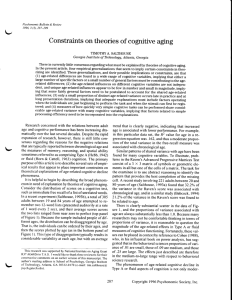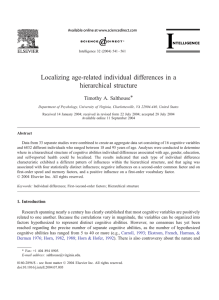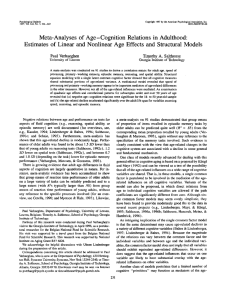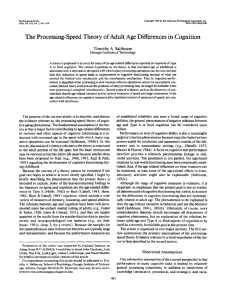Time as a Factor in the Development and Decline of Mental Processes
advertisement
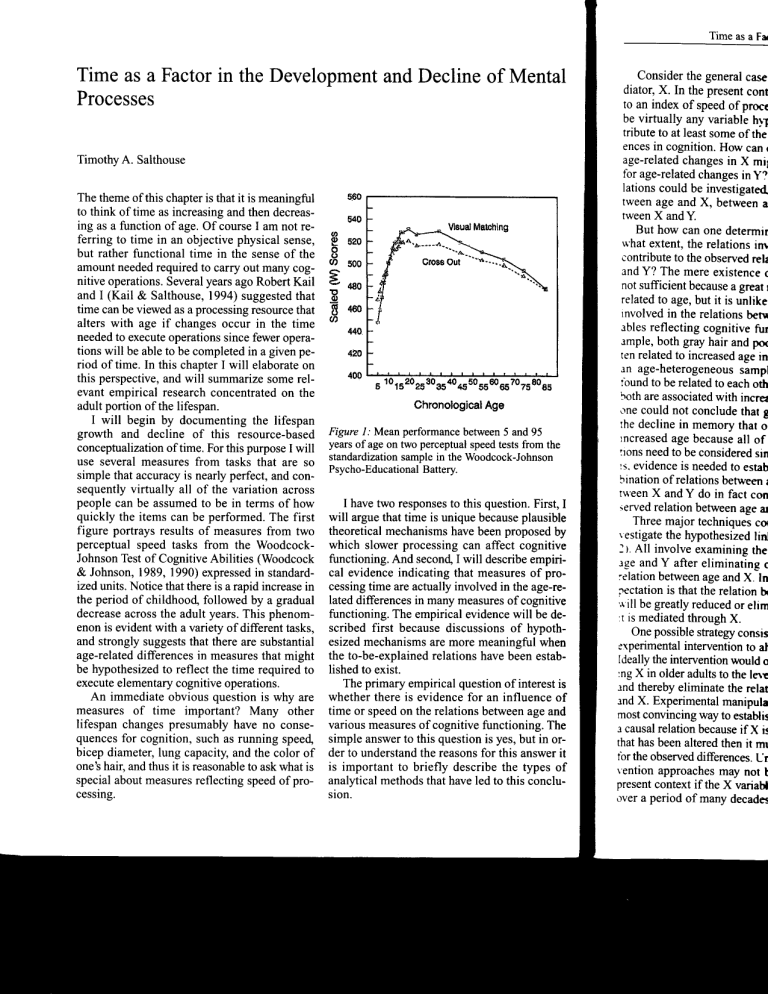
Time as a Fa
Time asa Factorin the Development
andDeclineof Mental
Processes
Timothy A. Salthouse
The theme of this chapteris that it is meaningful
to think of time as increasing and then decreasing as a function ofage. Ofcourse I am not referring to time in an objective physical sense,
but rather functional time in the senseof the
amount neededrequired to carry out many cognitive operations.Severalyears ago Robert Kail
and I (Kail & Salthouse,1994) suggestedthat
time can be viewed as a processingresourcethat
alters with age if changes occur in the time
neededto executeoperationssince fewer operations will be able to be completedin a given period of time. In this chapterI will elaborateon
this perspective,and will summarizesome relevant empirical researchconcentratedon the
adult portion of the lifespan.
I will begin by documenting the lifespan
growth and decline of this resource-based
conceptualizationof time. For this purposeI will
use several measuresfrom tasks that are so
simple that accuracy is nearly perfect, and consequentlyvirtually all of the variation across
people can be assumedto be in terms of how
quickly the items can be performed. The first
figure portrays results of measuresfrom two
perceptual speed tasks from the WoodcockJohnsonTestof CognitiveAbilities (Woodcock
& Johnson,1989, 1990)expressedin standardized units. Notice that there is a rapid increasein
the period ofchildhood, followed by a gradual
decreaseacrossthe adult years.This phenomenon is evident with a variety of different tasks,
and strongly suggeststhat there are substantial
age-relateddifferencesin measuresthat might
be hypothesizedto reflect the time required to
executeelementarycognitive operations.
An immediate obvious question is why are
measures of time important? Many other
lifespan changespresumably have no consequencesfor cognition, such as running speed"
bicep diameter,lung capacity,and the color of
one'shair, and thus it is reasonableto ask what is
specialabout measuresreflecting speedofprocessing.
500
uro
E
o
o
(r) 500
I
;
-E
480
I 460
o
1140.
420
400
6
101s20253035404550556065702S80gS
Chronological
Age
Figure I: Mean performance between 5 and 95
years of age on two perceptual speedtests from the
standardizationsample in the Woodcock-Johnson
Psycho-EducationalBattery.
I have two responsesto this question. First, I
will argue that time is unique becauseplausible
theoretical mechanismshave been proposed by
which slower processingcan affect cognitive
functioning. And second"I will describeempirical evidence indicating that measuresof processingtime are actually involved in the age-related differences in many measuresof cognitive
functioning.The empirical evidencewill be described first because discussions of hypothesizedmechanismsare more meaningful when
the to-be-explainedrelations have been establishedto exist.
The primary empirical question of interest is
whether there is evidence for an influence of
time or speedon the relationsbetweenage and
various measuresof cognitive functioning.The
simple answerto this questionis yes, but in order to understand the reasonsfor this answer it
is important to briefly describe the types of
analyticalmethodsthat haveled to this conclusion.
Consider the general case
diator, X. In the present cont
to an index ofspeed ofproct
be virtually any variable h11
tribute to at least some of the
encesin cognition. How can r
age-relatedchangesin X mi1
for age-relatedchangesin y?
lationscould be investigare
tween age and X, betweena
rweenX andY.
But how can one determi
*'hat extent,the relationsim
contributeto the observedrcll
andY? The mere existence<
not sufficient becausea great I
relatedto age,but it is unlike
rnvolvedin the relationsberc
ablesreflecting cognitive fui
.rmple,both gray hair and po<
renrelatedto increasedage in
rn age-heterogeneoussamp
rbundto be related to eachoth
roth are associated
with incre
.''necould not concludethat g
rhe decline in memory thar o
rncreased
age becauseall of
rronsneedto be consideredsin
rs.evidenceis neededto estab
binationof relationsbetweenI
r*'een X and Y do in fact con
.erved relation betweenage ar
Three major techniquesco
restigatethe hypothesizedlinl
I t. All involve examining tbe
rge and Y after eliminatingc
:elationbetweenageand X. In
rectationis that the relation h
'.rill be greatlyreducedor elim
:r is mediatedthroughX.
One possiblestrategyconsis
:rperimental intervention to al
Ideallythe interventionwould o
:ng X in older adultsto the le\t
rnd thereby eliminate the rclar
rnd X. Experimental manipula
mostconvincingway to establi
a causalrelation becauseifX is
rhathas beenalteredthen it mr
tor the observeddifferences.Ur
vention approachesmay not t
presentcontext ifthe X variaH
over a period of many decadc
Time as a Factor in the Development and Decline of Mental Processes
ine of Mental
logical Age
x-c bctween5 and 95
rrual ipced testsfrom the
rhl \\oodcock-Johnson
c'
, to this question'First, I
rn'quebecausePlausible
i h.1\c beenProPosedbY
n! can affect cognitive
d- l ri rll describeemPiris th.rrmeasuresof ProN rnrolvedin the age-renr nr.'u.rr.esof cognitive
'r"-rlcvidencewill be dedr.cttssionsof hYPothr rnrrremeaningfulwhen
l.itr,'nshavebeenestabcal questionofinterest is
encc tbr an influence of
elrtlonsbetweenageand
ocnrtivefunctioning.The
quc.tionis Yes,but in oric'.i:onsfor this answerit
lr ,lescribethe tYPesof
ri h"r'. led to this conclu-
Consider the general case of a potential mediator, X. In the present context X corresponds
to an index ofspeed ofprocessing,but it could
be virtually any variable hypothesized to contribute to at least some of the age-relateddifferencesin cognition. How can one determine that
age-relatedchangesin X might be responsible
for age-relatedchangesinY? Severalsets ofrelations could be investigated,such as those between age and X, betweenage and Y, and between X andY.
But how can one determine whether, and to
what extent, the relations involving X actually
contribute to the observedrelations betweenage
and Y? The mere existenceof each relation is
not sufficient becausea great many variablesare
related to age, but it is unlikely that they are all
involved in the relations between age and variables reflecting cognitive functioning. For example, both gray hair and poor memory are often related to increasedage in adulthood"and in
an age-heterogeneoussample they might be
found to be related to eachother merely because
both are associatedwith increasedage.However
one could not conclude that gray hair mediates
the decline in memory that often accompanies
increasedage becauseall of the relevant relations needto be consideredsimultaneously.That
is, evidenceis neededto establishthat the combination ofrelations betweenage and X and between X and Y do in fact contribute to the observedrelation betweenage andY.
Three major techniquescould be used to investigatethe hypothesizedlinkages (see Figure
2). All involve examining the relation between
age and Y after eliminating or controlling the
relation betweenage and X. In eachcasethe expectation is that the relation between age andY
will be greatlyreducedor eliminatedif much of
it is mediated through X.
One possiblestrategyconsistsof sometype of
experimentalintervention to alter the level of X'
Ideally the intervention would operateby improving X in older adultsto the level of young adults,
and thereby eliminate the relations between age
and X. Experimental manipulation is clearly the
mostconvincingway to establishthe existenceof
a causalrelation becauseifX is the only variable
rhathas been altered then it must be responsible
tbr the observeddifferences.Unfortunately,intervention approachesmay not be feasible in the
presentcontext if the X variable changedslowly
,.rvera period of many decades.Not only might
JJ
Inbffenlbn
l v l
Ac.
-
[Q\-]
l v l
Agc
'[Gl
l Ae.
" l
Agf
Manctrrne
fr*-.1
.'.'-'
I
|
Ae.
HH,nrdu
lo
l
Ae.
Figure2: Schematicillustrationof threetechniques
thatcouldbe usedto eliminatethevariation
betweenageandsomevariableX.
interventionsbe ineffective in reversingchanges
that were slow and gradual,but ifthe changein X
occurred gradually, it may have been accompanied by numerous adaptationsthat might not be
easyto eliminateeven if it were possibleto restorethe level ofX to the earlier state.
A secondpossiblesffategyinvolves the use of
matching by attempting to find people of different ageswho have similar valuesof X. Although
seemingly straightforward this procedurealso
has at least two major limitations. First, when
trying to match on a variable that has moderate
to large relationswith age,as is expectedto be
the casewith X, the matchedsampleswill likely
be small and the range of ages probably restricted relative to the entire sample. Both of
thesefactors will lead to low statisticalpower to
detectrelationsbetweenage andY, and consequently the hypothesisof attenuatedrelations
between age and Y might be supported for artifactual reasons.The second limitation of the
matching procedureis that there is no assurance
that the matching is only on the intendedvariable X becauseseveralvariables may vary concomitantly with X, and one or more of them may
influenceY in addition to, or insteadof, X. To
the extentthat this is the case,one could not be
certain that X was the critical variable responsiblefor the changesinY.
34
Time as a Fa
Timothy A. Salthouse
The third strategythat could be usedto inves- equationmodeling to reducemeasurementerror
tigate the role of a variable X in the relations and minimize biasesin the estimatesof the magbetween age and another variable Y relies on nitude of the relations.However,the analysesare
sometype of statisticalcontrol.That is, statisti- still meaningful with observedor manifest varical control procedures could be used to equate ables,particularly ifreliabilities are availableto
people ofdifferent ageson X by partialing out allow the estimatesof the relations to be adthe linear relation betweenage and X. An advan- justed for measurementerror.
In both commonality analysesand path analytage of equating with statistical procedures
the methods are relevant to time-based interses
rather than through direct matching is that all of
if measuresof processing speed are
pretations
the
analyses,
in
be
used
the availabledata can
measuresof cognitivefunctioning
and
X,
as
used
in
statistical
reduction
is
minimal
there
thus
and
power relative to the entire sample. Statistical are usedasY. Resultsfrom theseprocedureswill
control proceduresalso allow the influence of be illustrated with perceptualcomparison speed
other measuredvariables to be examined and measuresserving asthe X variable,and measures
eliminated by similar partialing techniques.The of performance from three different cognitive
primary assumptionof statistical control proce- tasksserving as theY variable.
As mentioned earlier, perceptual speedmeadures is that the relations between age and X,
quickly eland between X and Y, are mostly linear, or that sures are assumedto reflect how
be percan
operations
cognitive
ementary
yield
linear
the variables can be transformed to
that few
so
simple
are
tasks
is,
the
That
formed.
is
determined,
relation
linear
relations. Once the
virtuit can then be used to adjust the valuesofY to people make mistakes, and consequently
is
adults
normal
across
variation
the
of
remove the influence of X, and allow examina- attyatt
tasks.
perform
the
to
needed
the
time
in
reflected
portion
and
the
tion ofthe relation between age
Administration time for the measurescan be as
ofY that is independentof X.
reliability
Becauseinterventions do not yet appearfea- brief as 60 seconds,but estimatesof
will
be deI
Although
higher.
or
sible, and since matching leadsto substantialre- are often .8
propaper-and-pencil
on
based
results
scribing
procedures
ductions in power, statistical control
patterns
similar
that
noted
be
should
it
cedures,
eliminatfor
method
practical
may be the most
and path
ing the influence of a hypothesizedmediating of results in commonality analyses
time
reaction
with
obtained
been
variable at the current time. Two different statis- analvseshave
not
do
the
conclusions
thus
and
-"usutes,
rpe"d
tical control methodscan be used"both of which
asof
method
particular
to
a
be
specific
to
seem
procearebasedon relatedtypes ofcorrelational
sPeed.
processing
sessing
dures.
Results with three different criterion meaOne method is known as commonality analywill be illushated and in eachcasethe data
sures
sis, and it is useful for determininghow much of
based on samplesof 200 or more adults
were
is
much
how
to
X,
the variance in Y is unique
from l8 to over 80 years ofage. One of
ranging
X
between
is
shared
much
how
and
age,
unique to
on the Raven's
and age. This technique is particularly helpful the criterion variablesis the score
test of
popular
is
a
which
Matrices,
Progressive
when partitioning the age-relatedvariance bein a
9
cells
8
of
in
which
reasoning
inductive
the
age-related
of
causeit can indicatehow much
the reand
patterns
geometric
contain
matrix
(Y)
is
shared
variable
the
criterion
variance in
spondentis requiredto selectthe best comple'
with the hypothesizedmediator variable(X).
A second
Various types of path analysiscan function as tion of the missing cell in the matrix'
of
number
of
the
the
sum
is
variable
criterion
because
the secondstatistical control procedure
in the
trials
five
first
the
across
recalled
items
strengths
relative
the
of
they provide estimates
Test. In this test
of paths from age to X, from X to Y, and from Rey Auditory Verbal Learning
is read aloud
words
l5
unrelated
list
of
the
same
agetoY. The latter path is especiallyinformative
to reattempting
respondent
the
with
times,
five
onY
ofage
becauseit representsthe influence
preseneach
possible
after
as
words
many
as
call
it
can
thus
and
X,
through
that is not mediated
and accuracy
be used to estimatehow much of the age-related tation. A measurereflecting time
Wechsler
the
from
test
Design
variancein Y is not explainedby the mediator on the Block
the third
is
Revised
Scale
Intelligence
Adult
con(X). Ideally the path analysesshould be
test inThis
will
describe.
I
variable
criterion
structural
and
ducted with latent constructs
volves the respondentanen
blocks to match a target panl
These three tests are obv
ent, and they are generalll.
distinctpsychometricfacton
soning,episodic or shon-tern
tial visualization).Eachof th
tablishedto havegood reliab
the teststypicallyexhibit rn
differences.The next figure
from studiesconductedin n
the scoresin eachtest con\.e
viation units from the enrrre:
comparisonsacrossvariablr
range of performance from I
oldestage groups is almostr
tions with each variable.
AgeTrends
Baven's
R€yAVLT
WAISBlod<Delgn
:'igure 3: Mean standardscores(
\latrices (Salthouse,1993),and r
ialthouse,Fristoe& Rhee, 1996
.rrth thesevariablesas criterion r
Time as a Factor in the Development and Decline of Mental Processes
iasurementerror
laresof the mag, th!'analysesare
or nianifest varis are availableto
ationsto be ads and path analYintertrnie-based
e\sing speedare
ritire functioning
e procedureswill
onrparisonspeed
rlc. and measures
flcrent cognitive
ptual speedmeaherrrquickly elns can be pero simplethat few
nscquentlYvirtunormal adults is
pcrtbrm the tasks.
easurescan be as
atcsofreliabilitY
rgh I will be derr-and-pencilPrort :irlilar Patterns
nalvsesand path
r rth reactiontime
'onclusionsdo not
ular methodof asnt criterion meaeachcasethe data
)0 or more adults
ars ofage. One of
c-rreon the Raven's
s a populartest of
r S of 9 cells in a
,rrc'rnsand the ret the best comPle: nratrix.A second
r-rfthe number of
;t tive trials in the
rg Test.In this test
r-ordsis read aloud
nr attemptingto re: alier eachPresentlntc and accuracy
ionr the Wechsler
ier ised is the third
cnbe.This test in-
volves the respondentattempting to assemble
blocks to match atarget Pattern.
These three tests are obviously quite different, and they are generally assumedto reflect
distinct psychometricfactors (i.e., inductive reasoning,episodic or short-term memory and spatial visualization).Eachofthe testshasbeenestablishedto have good reliability, and scoreson
the tests typically exhibit moderately large age
differences.The next figure illustrates results
from studies conducted in my laboratory with
the scoresin eachtest convertedto standarddeviation units from the entire sample to facilitate
comparisonsacrossvariables.Notice that the
range of performance from the youngest to the
oldest age groups is almost two standarddeviations with eachvariable.
AgeTrends
The next figure illustratesresultsu'ith commonality analyses(in the form of a pie chart depicting variance accounted for in the criterion
variable)and path analyses(in the form ofa path
diagram with estimates of the relevant coefficients). Results from both sets ofanalyses are
consistentwith the interpretation that time to
executesimple operationsis an important factor
in the age-relateddifferences in cognitive functioning. This is apparent in the commonality
analysesbecauseestimatesofthe percentagesof
the total age-relatedvariance sharedwith speed
(i.e., the ratio of sharedto the sum of sharedplus
unique-to-agemultiplied by 100)were 98.1 for
the Raven'svariable, 73.2 for the Rey Verbal
Learning variable, and 86.3 for the Block Design variable. The path analysis results are also
CommonalitYEEtimat€€
PathModels
Baven's
o
8
g,
r{l
-l
ReyAVLT
{.t
WAISBlod<Deign
I
INt
" ' ' ! 0 s $ s D F
Raven'sProgressive
Figure 3: Mean standardscores(and standarderrors) as a function of age for the
Block Design Test
Wechsler
and
Test
Learning
Verbal
M"atrices(Salthouse, 1993), and ih. R.y Auditory
path analyses
(Salthouse,Fristoe & nfree, ISSO).Also portrayed are results from commonality analysesand
with these variables as criterion variables.
36
Timothy A. Salthouse
Time as a Facrc
firfrdTrmPrinide)
tary processingoperationstake
formed, then fewer of them can
a given period. This mechanis
very important in timed tesrs
those with low levels of difficu
formance is primarily assesse
number of items completed i
time. However, the limited r
could also affect performancei
situations where a sequenceof
be performed and slow execu
operationsmeansthat later. and
order,operationsare not succes
A relevantmetaphorfor the lim
nism might be an assemblyline
operationsare not completedn
ucts at subsequentstagesmar t
Considerableevidenceindic
creasingage less processine
plished in the same amount (
ample,this phenomenonis er id
lationsof stimuluspresentatio
hoc analysesofthe level ofaccr
specifiedreactiontimes,or u'id
ing reaction time to the amou
processingor to the number ot
must be performed.
The secondmechanismb'r'rr
cessingcould leadto impairme
of cognitive functioning is knon
neity mechanism,and it ma1 og
thereare no externaltime limiu
sumptionin this mechanismis t
successfulmany higher-level ,
tions such as association.inte
stractionrequire that all of the r
tion is simultaneouslyavailab
accessiblewhen needed,then rh
not be completedsuccessfullr.:
the relevantperformanceu'ill b
eral factors probably affect the i
taneouslyavailable informatior
activatethe informationis posru
ticularly important determinan
It could be arguedthat if infc
in the samestateof availabilin
the completionof processingn
layed when the speedof actn
However,if information is lost
displacementthen therewill be
when all relevantinformation i
the duration ofthat period dep<
namicsof the speedof activatl
|
I
E
3
E
Age -+
./
Spood
,.n
2:
fln
\
Gogniton
(Sl'rrulhnc{tyRhtdcl
g
5r
\
l
/N
f,l
r I f f/J"-\onlo
iffi
rlat
./
'
nffir
bldrdl
Figure 4: Schematic illustration of two hypothesizedmechanismsthat might account for the influence of
speedon the relations between age and measuresofcognitive performance.
consistentwith the hypothesizedspeedmediation becausemoderately large coefficients were
evident for the paths from age to the speedvariable and from the speedvariable to the cognitive
variable. Moreover, in each case the direct or
unmediatedrelation betweenage and the cognitive variable was substantially smaller than the
correspondingcorrelation(e.g.,for Ravens,-.30
vs. -.57; for RAVLT, -.33 vs. -.50; and for Block
Design,r: -.23 vs. -.47).
The resultsjust describedclearly indicate that
a substantialproportion ofthe age-relatedvariance in severalcomplex cognitive measuresis
sharedwith simple measuresthat are hypothesizedto reflect how quickly simple processing
operationscan be executed.However,it is important to emphasizethat not all age-relatedeffects on complex cognitive measuresare shared
with simple speed measures.Results such as
those I havejust describedare sometimesmisinterpretedas implying that a single monolithic
factor is responsiblefor all ofthe age differences
observedin measuresof cognition. In fact, an
advantageof thesetypes of correlational proce-
dures is that they allow the relative contribution
of different types of influencesto be determined,
insteadof focusing exclusivelyon whether the
influence of a particular variable is different
from zero, as is often the casewith other analytical procedures.The results of these analyses,
and of similar analysesof other data, suggest
that measuresof simple processingefficiency
share large proportions of age-relatedvariance
with several different types of complex cognitive
variables. They are thus consistent with the interpretation that factors related to processing
speedcontribtte to some of the observedage
differences in variables representinghigher-order cognitive functioning.
Now that the relations involving processing
speedhave been establishedto exist, it is appropriate to ask about the mechanismsthat might be
responsiblefor those relations. I believe that at
least two speed-basedmechanisms,which are
schematically illustrated in the next figure, are
involved in the age-relatedeffects on cognition
(Salthouse,1996).I refer to one mechanismas
the limited time mechanismbecauseif elemen-
Time as a Factorin the Developmentand Decline of Mental Processes
\
Cognition
./
u:,: lirr theinfluenceof
rhc rr'lativecontribution
u!'nccsto be determined
:lu.rr c'lyon whetherthe
lar rrriable is different
e c.r\L'withotheranalytisuli. of theseanalyses,
\ .\j' other data, suggest
le firr)cessingefficiency
variance
i \'l .rge-related
p..r oI complex cognitive
-i c()nsistentwith the inrs rclatedto processing
' n r t r r l ' t h eo b s e r v e da g e
s r!'presentinghigher-orng
rn] lnvolvingprocessing
ishcdto exist.it is approncehlnisms that might be
elltr,rns.I believethat at
mr'chanisms,which are
rd rn the next figure, are
arcJ effectson cognition
ler to one mechanismas
nr\nr becauseif elemen-
tary processingoperationstake longer to be performe4 then fewer of them can be completed in
a given period. This mechanismis likely to be
very important in timed tests, and especially
those with low levels of difficulty in which performance is primarily assessedin terms of the
number of items completed in the specified
time. However, the limited time mechanism
could also affect performance in more complex
situations where a sequenceof operationsmust
be performed and slow executionof the early
operationsmeansthat later, and possibly higherorder,operationsare not successfullycompleted.
A relevantmetaphorfor the limited time mechanism might be an assemblyline in which if early
operations are not completed rapidly, the products at subsequentstagesmay be defective.
Considerableevidenceindicatesthat with increasing age less processing can be accomplished in the same amount of time. For example,this phenomenonis evidentwith manipulationsof stimuluspresentationtime, with posthoc analysesofthe level ofaccuracyobtainedat
specified reaction times, or with functions relating reaction time to the amount of completed
processingor to the number of operationsthat
must be performed.
The secondmechanismby which slowerprocessingcould leadto impairmentsin the quality
of cognitive functioning is known asthe simultaneity mechanism,and it may operateeven when
there are no external time limits. The critical assumption in this mechanismis that in order to be
successfulmany higher-level cognitive operations such as association,integration and abstraction require that all of the relevant information is simultaneouslyavailable.If it is not all
accessiblewhen needed,then the operationsmay
not be completedsuccessfully,and the quality of
the relevant performancewill be impaired. Several factors probably affect the amount of simultaneously available information, but the time to
activatethe information is postulatedto be a particularly important determinant.
It could be arguedthat if information remains
in the samestateof availability indefinitely then
the completionof processingwill merely be delayed when the speed of activation is slower.
However,if information is lost through decayor
displacementthen therewill be a limited period
when all relevant information is available, with
the duration ofthat period dependenton the dynamics of the speedof activation and the rate of
3 t
loss or forgetting.Moreover,becauseit is unrealistic to expect information to remain in a high
stateof availability indefinitely, speedof activation is likely to be a critical variable affecting the
amount of information that is simultaneously
available.
It might still be possibleto achievethe same
eventual level of higher-order products if the
rate of loss of information was slowed to the
sameextentas the rate of activation.However,in
order for this to occur the information must not
be lost as rapidly in older adults comparedto
young adults,and there is no evidenceto suggest
that the rate of forgetting is slower with increasedage. Instead most of the relevant research suggeststhat the rate of forgetting for
older adults is either the sameas that of young
adults, or possibly even faster, but certainly not
slower(seeSalthouse,1992).
Becauseit is difficult to obtain precisemeasuresof the time courseof information availability, very little evidencedirectly relevantto the
simultaneitymechanismis currently available.
Although this mechanismis largely speculative
at the present time, it seems plausible as a
mechanismby which slower speedof processing
could lead to lower levels of cognitive performance.
Summary and ImPlications
I will now summarizethe major points of this
chapter.First, I suggestedthat effective or functional time decreaseswith increasingage, and
that it seemslikely that this decreasehasconsequencesfor many types of cognitive functioning. Second resultsfrom two correlationalprocedureswere describedthat indicate that measuresof processingspeedare closely involved in
the relations betweenage and severaltypes of
cognitive functioning. And thir4 two mechanisms hypothesizedto contributeto the role of
speedon cognition,limited time and simultaneity, were discussed.I believethat the combination of plausible argumenttogetherwith relevant
empiricalevidencelendscredibility to the timebased interpretation of developmentaldifferences in cognition. However, much more researchis clearly neededbefore this interpretation would be completely convincing. For example, more analyticalresearchis desirableon
the mechanismsthat areresponsiblefor the speed
38
Timothy A. Salthouse
T. A. (1992).Influenceof processing
mediation that has been establishedto exist. Fi- Salthouse,
adult age differences in working
on
speed
nally, it is important to capitalize on the strengths
79, 155-170'
Psychologica,
Acta
memory.
of different methodologicalapproaches'because
T. A. (1993). Influence of working
Salthouse,
both correlational and experimental procedures
in matrixreamemoryon adultagedifferences
provide valuable information. For example,corsoning.British Journal of Psychology'84' l7l'
ielational proceduresare useful to estimate the
199.
speedtheory
strength of relevant relations, and experimental Salthouse,
T.A. (1996).Theprocessing
procedures are useful to explore the nature of
ofadult agedifferencesin cognition'Psychological Review,103,403-428.
lhe mechanismsresponsiblefor the relations.
N', & Rhee,S' H. (1996)'
T. A., Fristoe,
Salthouse,
effectson neuropHow localizedareage-related
sychologicalmeasures?Neuropsychology,10,
References
272-285.
R. W., & Johnson,M. B. (1989'1990)'
Woodcock,
speed
(1994).
Processing
T.
A.
Kail"R..& Salthouse,
BatteryPsycho-Educational
Woodcock-Johnson
S6,199asa mentalcapacity.ActaPsychologica,
Allen, TX: DLM.
Revised.
225.
Distortionsof Mr
Elizabeth F. Loftus
A famous story told by Pi
memory distortion has long
tion ofAmerican psycholog
ther research,and so it seen
chapter for a book celebrati
his birth with a reminder ol
ferring to Piaget'sclassic ch
an attemptedkidnapping tha
pened to him early in his
194511962).The false mern
stayedwith him for at least r
"... one
of my fir
date,if it were true. fi
I can still see,most cl
scene, in which I b
about fifteen. I was
which my nurse w
Champs Elys6es, n'l
kidnap me. I was helr
tened round me whil
tried to stand betwec
She receivedvarious
still see vaguely tlx
When I was about fil
ceived a letter from r
shewantedto confess
in particular to retun
been given as a re$an
up the whole story ..
have hear4 as a child
story, which my par
projected into the pa
visual memory."
Piaget'sstory illustrates t
.:eate a vivid memory in tl
.hich is why I found it use
:":rly analysis of the controrn
-cmories (Loftus, 1993).k
: r. false memory appearsto
-:ough a story told at that
::rrugh subsequentfamil,vn
: -estion about the extent ft
:r.ne to forming vivid but u
: rgs that happenedin our p
:-.. who also have used the I





